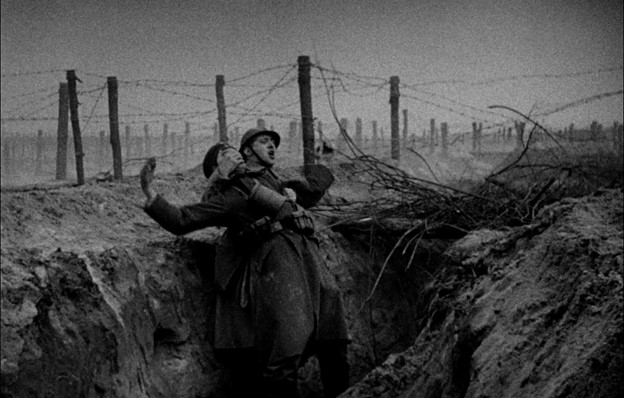Westfront 1918 (1930)
G.W. Pabst's "Westfront 1918"
By 1930, sound pictures were the new mainstay format of the film industry. G.W. Pabst, who had just completed work on some of the greatest silent films of the Weimar Republic, made a film that was notable for its use of sound. "Westfront 1918" demonstrated how sound could be used as a primary vehicle for the film, rather than just as an accompaniment. It depicted the events of the first World War, through the eyes of a handful of German soliders. The war, which had just ended a decade prior, was still fresh in the minds of the German citizens. "Westfront 1918," with its ability to place you directly in the heart of the action, was an emotional and visceral experience for audiences in 1930.
The film centers on four infantrymen - the Bavarian, the student, the lieutenant, and Karl. Not only is Karl the only named character, but also the only character whose life outside of war we actually get to see. After the men defend their base from friendly fire, Karl is given leave. While at home, he discovers his wife has been sleeping with the butcher boy for meat. It is clear to the viewer that war is not only hell on the battlefield, but hell for the people back home as well. Poverty is at an all-time high, as we see through the long lines for bread. Once Karl gets back on the front, his men are attacked by the French. The film ends with all of the characters dead, including Karl.
If there is one thing a good war film should be, it is an anti-war film. "Westfront 1918" succeeds at being exactly that. Its depictions of the horrors of war are unflinching. Pabst's camera places us directly in the trenches with the men, as explosions and gun fire are happening all around them. Opposing forces move slowly upon them, taking them out one by one. The visual renderings by Pabst display the results of this. One such image shows a man's hand sticking out of the mud, as the men throw dirt on him to bury him up. Another such image is the last one, in which we are taken into the medical ward. Men are wailing and screaming with bandages, blood, and missing limbs. Siegfried Kracauer describes the scene as being like a medieval torture picture, like the kind our of a history book. Pabst makes it very clear how hellish this wartime reality is.
Pabst also utilized sound is a brilliant way. While most new sound pictures were having to keep their sound recorders sealed in a booth, Pabst used a mobile soundproof case, so he could use sound directly in the middle of the action sequences in the trenches. With this, explosions and gunfire are happening in real time and are captured in the moments of war. The loud, harrowing noises are even more effective due to Pabst's use of silence in the film. The film doesn't contain an abundance of dialogue, especially when we are in the trenches. Because of this, there are lots of quiet moments in the picture. This abundance of silence makes the loud moments that much more terrifying.
All in all, "Westfront 1918" was well regarded by the German people. It depicted an event most German had a memory of. Because of Pabst's explorations with 'New Objectivity' in some of his silent films, he was well equipped to bring a gritty realism to "Westfront 1918." This realism, as well as the effective utilization of sound, and the harrowing depictions of destruction, poverty, and death, created a visceral and somber watch for German audiences. The film was not well regarded by some Germans however, specifically Joseph Goebbels. Soon to be the Minister of Propaganda, Joseph Goebbels worked to have the film denounced. The Nazi party was quickly taking over via Nationalist Socialism and was slowly working to get its citizens ready for more war. Because the film offered a pacificist perspective, the film was deemed unsuitable for public consumption by the party. Goebbels even labelled the film as "cowardly defeatism." Despite the sinister means for which they tried to censor the film, its affects were still felt. "Westfront 1918" was a crowning achievement for Germany in 1930. Its denunciations of war were not said, but felt. The film put the viewer in the middle of hell and demonstrated with its grittiness, gruesomeness, and violent sound-making how inescapable death becomes.




Comments
Post a Comment